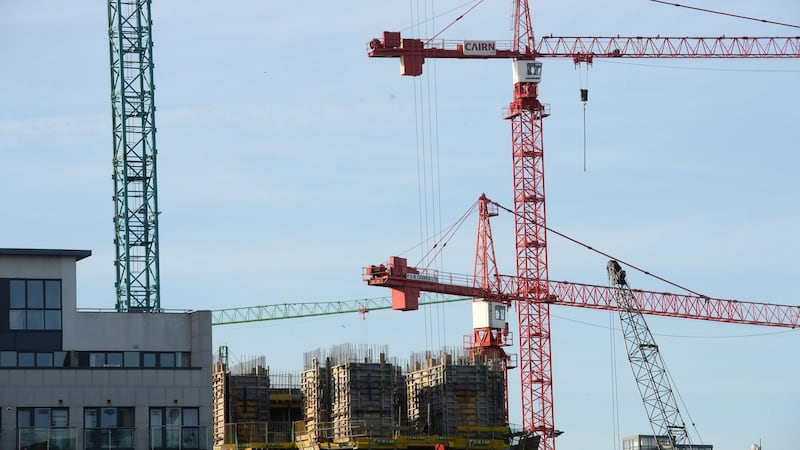It was the tie that gave it away. Paddy Kelly, one of Ireland's biggest developers, and his son Simon had just visited the headquarters of Anglo Irish Bank in 2008 to get an extra credit line.
The Irish property market was in meltdown, but it wasn’t clear yet that we were heading into western Europe’s biggest real estate crash.
“Things must be bad if you’re wearing a tie,” I joked to Paddy, who was famous for avoiding them. “We’re f***ed,” Simon said, typically blunt.
In the space of 12 months, their Redquartz group saw net assets of €300 million become net debts of €200 million. It has been 10 years since the State nationalised now-defunct Anglo, the bank of choice for Irish developers such as the Kellys because of the speed and laxity with which it handed out money.
Could another one happen? The answer is yes. What’s more, the culprit is soaring residential land prices, which were a cause the last time around, leaving half-completed housing developments dotted across the country like tombstones.
That's why we didn't get out. You believe the local narrative, and then the story whips you in the ass
Paddy’s family home was Clonmore, a six-bedroom house he had built, with a pond and floodlit tennis court, on Shrewsbury Road in Dublin. With the market imploding after the crash, Paddy rented it to the Chinese ambassador. Now he was asking €10 million for it. Only one serious bidder came forward, and Clonmore sold for almost 20 per cent below that last December.
Ten years after Paddy told the courts he was effectively bankrupt, the family are still working out their loans. They were the first of Ireland’s major developers to admit they had lost everything.

Instead of taking cash off the table during the boom, they had reinvested the profits: a hotel at Sawgrass Golf Resort and Spa in Florida; Dublin office buildings (since leased to companies including Amazon); the former athletes’ village for the 2006 Turin Winter Olympics (now a Club Med ski resort). They lost them all.
“We totally bought into Ireland’s growth story,” says Simon. In Dublin, sleek bars and restaurants proliferated. Helicopters, yachts, mansions in Spain – “these became almost everyday accoutrements to the lifestyles of the rich and Irish.
“That’s why we didn’t get out. You believe the local narrative, and then the story whips you in the ass.”
Starting again
As the economy buckled, Simon ended up writing a newspaper column at the Sunday Tribune in which he apologised for the “damage” the developers had caused. Paddy is a serious believer in reincarnation. Which is good, because he says he’s ready to start again.
The family's debts are now owed to American real estate investment group Colony Capital, and he would like to see if he and Colony can build a business together. Buying residential land won't be on the agenda, though. Instead, he is considering shorting Irish home-builder stocks because of the eye-watering prices the companies have been paying for land. "You have to get your timing right," he says.
“The property market quickly becomes sour bread.” He switches metaphors, clinging to hope: “The party ended at midnight, and now it’s 2am and there are still some stragglers hanging around.”
From the early 1990s through the early 2000s, rapid economic growth, propelled by an influx of tech companies and a burgeoning young workforce, changed Ireland from a grim place of emigration to one of immigration and virtually full employment.
A property boom followed: the country’s population rose almost 20 per cent in the decade through 2008, boosting demand for homes, stores and offices. Successive governments used taxes from property sales to fund long-term spending, much of which went into wage increases that, in turn, were ploughed into ever more expensive real estate. Ireland became addicted to construction, which made up a quarter of gross domestic product in 2007.
From 2007 to 2010, unemployment trebled, to 15 per cent. Home prices fell by almost half. When you’re looking for a bubble in property markets, you keep an eye on land prices. They’re based on “hope value”.
Land values are stratospheric. But good luck to the people who bought it, because they will have to work hard with that land to generate a return
The amount of money developers bid is based on what they think the homes will sell for when they’re built. That speculation was at the root of Ireland’s property crisis. In the two years through June 2007, land prices in Ballsbridge rose as much as 150 per cent. When the bust came, land values plummeted more than 90 per cent in some cases, because nobody wanted to risk building homes in a downturn. Most of the developers who spent big money on land in Ballsbridge lost control of it, and it sat idle for years.
Nerves jangling
So it's no wonder nerves started jangling again a few years ago. Thanks to a weak euro and expansion by tech companies such as Facebook and Google parent company Alphabet, attracted by Ireland's favourable tax regime, the economy began recovering in 2013. Ever since, home values have been roaring back as if the last crash never happened. House prices rose almost 80 per cent between their trough in 2013 and the middle of last year, according to government statistics.
There’s been a corresponding surge in urban land prices: despite the eerie presence of hundreds of unsold or abandoned “ghost estates” dotting the countryside, shortages of homes in Dublin or Cork have spurred demand for land on which to build rental housing.
This worries Brendan McDonagh, chief executive of the National Asset Management Agency. When Nama put up land for sale last year, he says, it received bids that were in some cases 60 per cent higher than expected. "Land values are stratospheric," he says. "But good luck to the people who bought it, because they will have to work hard with that land to generate a return."
McDonagh, a former director of finance, technology, and risk at the National Treasury Management Agency, should know. In May 2009 he was on loan to the Department of Finance, working on bank bailouts, when he took a call from then minister for finance Brian Lenihan, who asked him to head up Nama. "I asked him if I had a choice," McDonagh says. "And he said no."
Ireland was the bravest in terms of being one of the first countries to sit down and tackle the problem
Nama took on 11,500 property-related loans from five domestic banks, including Anglo, in an effort to clean up their balance sheets and get them lending to the “real” economy again. Was a soft-spoken civil servant like McDonagh the natural person to do this? “Personally, I would have probably thought not,” he says. “I had no link to the construction industry. So, you know, you get on with the job. Somebody’s got to do it, and the country was in a hard place.”
McDonagh also understands credit, and he’s scathing about the corporate governance and lending standards that passed for rigour at Irish lenders before the crash. “Everyone was championing the banks and so proud of them,” he says. “It was all a fiction. Nobody was looking after the housekeeping, including the regulators at the time.”
Disproportionately clobbered
By 2005 Irish bank assets exceeded GDP. Two years later, Anglo’s assets hit €97 billion, having increased 22-fold since 1998. The disproportionate size of the banking industry meant that during the financial crisis, Ireland was disproportionately clobbered compared with other countries.
“But then Ireland was the bravest in terms of being one of the first countries to sit down and tackle the problem,” says McDonagh. “If you look at other countries that had banking problems, some of them still haven’t resolved them.”

At the height of the crisis, McDonagh says, “the country was febrile”. He basically stopped socialising for a year and a half, weary of being lambasted about the state of the economy by people when he went to the pub. “I often had to remind myself that you can’t take it personally,” he says. “But of course you do.”
Pat Gunne is chief executive of Green Reit, a Dublin-based real estate investment trust with properties worth €1.5 billion in its portfolio, including Barclays' EU headquarters in Dublin.
Gunne emerged as one of the property downturn’s winners, but he had his struggles along the way. Always a private person, he visibly winces when asked to discuss his personal experiences of the crash. The loan-to-value ratio of the mortgage on a home he bought in 2006 rose from 50 per cent to 200 per cent as prices collapsed.
"The level of value decline took us all by surprise," he says. And yet Gunne spotted an opportunity. He started by setting up a venture with Stephen Vernon, one of the few developers who sold off assets before the crash, to manage troubled loans and assets on behalf of the banks. The company, Green Property Ventures, ended up overseeing about €7.5 billion of assets in partnerships with Irish and UK banks and US private equity groups.
Brexit effect
Green Reit was born after the government introduced legislation allowing the creation of real estate investment trusts. The property crash. The financial crisis. And now Brexit, which is certain to have an adverse effect on Ireland as the UK, its largest trading partner, works out what its commercial arrangements are going to be with the rest of the world.
“Ireland,” says Gunne, “has to be open because it’s incredibly over-reliant on foreign direct investment and inward talent migration.” Looking back at the bubble across a decade of uneasy times, Gunne found it surprising how “very poor” risk controls were at some property companies that held assets valued in the billions of euros before the crash.
“Hindsight’s a wonderful thing, and I’ve made my own screw-ups,” he says, “but you learn from your mistakes. There is still opportunity, but, when you step back from it, rents are high, yields are low.”
Which means one thing: “It’s a time to be very focused on risk management.” – Bloomberg










